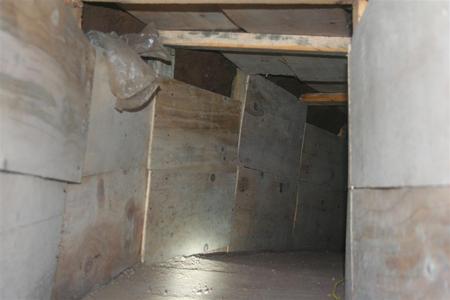One of the most publicized smuggling tunnels in Nogales, Sonora originated in a grave in the city’s cemetery, crossed under the U.S- Mexico boundary, and ended in a warehouse in the United States. Whether this tunnel is myth or reality is up for debate, but what is true is that the creation and use of such tunnels, to allegedly transport contraband, is on the rise. (On the Arizona border alone, officials have found 12 this year, up from four in 2000.) And according to a story in the Arizona Daily Star, they are impacting the local real estate business. Landlord Nanci Pottinger said that in one of her rentals the Border Patrol had previously sealed off a tunnel which came in through the fireplace. Not too good for business.
The tunnels and their impacts on local businesses in the borderlands are a small part of the much larger narrative about the nature of organized crime “raging along our southern border.” This month some politically powerful U.S. officials have racheted up this narrative, saying the U.S. counternarcotic strategy towards Mexico has not worked, and that it should be replaced by a counterinsurgency strategy.
A report, authored by former U.S. drug czar and Southern Command commander General Barry McCaffrey and former commandant of the U.S. Army War College, General Robert Scales, focuses on the Texas-Mexico border. "Texas Border Security: A Strategic Military Assessment" claims that organized crime syndicates from Mexico are following a “two-fold plan,” which is the equivalent of waging a “strategic-level” of war against the United States. The authors conclude that Mexican cartels “seek to create” a one-county-deep “sanitary zone” across the border in Texas which will turn border counties into narcotics transshipment points.
They wrote the report at the request of Texas Agriculture Commissioner Todd Staples, who testified in front of members of the House Committee on the Judiciary’s Subcommittee on Crime, Terrorism, and Homeland Security on September 19 to provide proof that the border “is not secure.”
It is not just crime, it is war, the report says. And its not just Mexico, it’s all of Latin America.
To make the case that narco-terrorism crosses the line from crime to war at the strategic level demands that the threat must extend beyond the border,” the report says, and, “clearly, America is being assaulted not just from across our southern border, but from across the hemisphere and beyond . . . All of Central and South America have become an interconnected source of crime, violence and terrorism. Drug cartels exploit porous borders using all the traditional elements of military force, including command and control, logistics, intelligence, information operations and the application of increasingly deadly firepower.
Almost in cue with the release of this report was the Western Hemisphere Subcommittee’s congressional hearing “Has Merida Evolved? Part One: The Evolution of Drug Cartels and the Threat to Mexico’s Governance.” The opening statement by Connie Mack (R-FL) reads like a call to military action against a “well funded criminal insurgency raging along our southern border, threatening the lives of U.S. citizens and harming the U.S. economy by undermining legal business,” such as, of course, real estate in Nogales.
“It is time that our determination to eradicate the cartels matches the cartels’ determination to undermine the freedom, security, and prosperity of the United States, Mexico, and the entire hemisphere,” Mack writes. According to Mack, U.S. drug war efforts, in the form of the $1.5 billion counter-drug package called the Merida Initiative, are not succeeding and are like, “showing up to a burning house, late, with a half assembled hose is a waste of time and tax payer dollars.”
Mack does not share the analysis of other Merida Initiative critics who say that the demand for drugs needs to be reduced, or that trade agreements that provoke poverty need to be renegotiated or revoked, because they help the illicit drug industry flourish.
Instead, Mack concurs with McCaffrey and insists that the United States has to develop a counterinsurgency strategy that includes doubling Border Patrol agents, “fully funding needed border protection equipment such as additional unmanned aerial vehicles and the completion of double layered security fencing in urban, hard to enforce areas of the border.” Don’t worry, there is also an educational part of the plan, a “culture of lawfulness program” that will insure that local populations “support the government, the rule of law, over the cartels.”
When the State Department responded to Mack’s statements saying that the Merida Initiative was working just fine, Mack accused them of “not closely tracking threat of Mexican drug cartels.” In the September 16 response, Mack even refers to the testimony of Dr. Gary M. Shiffman, managing director of the Chertoff Group, who identified “drug cartels as businesses that must utilize political manipulation to ensure profit: this is an insurgency.” What Mack doesn’t mention is that the for-profit Chertoff Group has a vested interest in the homeland security market, and a counterinsurgency effort would be profitable for them and other like-minded businesses. While local landlords might feel the economic fist of the border reality, other bigger fish are poised to profit from it.
As always, this proposed increased militarization would more likely impact unauthorized migrants crossing into the United States than drug traffickers, or "narco-terrorism," as McCaffrey puts it, and make them go to greater lengths to evade the border enforcement apparatus.
Though used for other reasons, the very existence of the Nogales tunnels are also a good indication of the many creative and resourceful ideas people have to get past the boundary, regardless of the U.S. anti-drug, counterinsurgency, or immigration deterrence plan. As scholar David Spener says in his ground-breaking book Clandestine Crossings,"Every obstacle placed thus far in their path . . . has been probed, evaluated, and ultimately evaded or overcome by millions of migrants whose principal ‘weapons’ in their struggle against their involuntary territorial confinement are their collective inventiveness, persistence, and traditions of mutual aid in the face of adversity.”
In terms of drugs, considering that most illicit narcotics come through the official ports of entry, and major U.S. banks in the United States launder drug money, there surely is a better answer than counterinsurgency.
For more from the Border Wars blog, visit nacla.org/blog/border-wars. And now you can follow it on twitter @NACLABorderWars. See also the May/June 2011 NACLA Report, Mexico's Drug Crisis; the Jan/Feb 2009 NACLA Report, Taking on Policy in the Obama Era; and the May/June 2007 NACLA Report, Of Migrants & Minutemen. Subscribe to NACLA.

